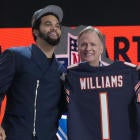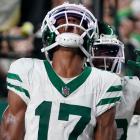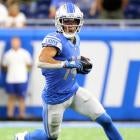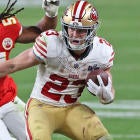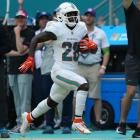Need Fantasy Football draft advice? Talk to CBS Sports on your Google Assistant to get insights on the best sleepers and to help decide between players. Just start with, "Hey Google, talk to CBS Sports."
Note: We published Dave Richard's positional strategy pieces early in August, and we're republishing them again before this big Draft weekend.
Imagine getting 9.96 Fantasy points from your No. 1 wide receiver. Imagine finding out that 9.96 is a good result!
Nine. Point. Nine. Six.
That was the average Fantasy point total for the top-12 wide receivers in non-PPR leagues last season. You could round it up to 10 if it makes you feel better, but either way, it's ugly.
Want to feel worse? Only six receivers averaged at least 10.0 Fantasy points per game in non-PPR last year. Another eight averaged between 9.0 and 9.8.
How about one more piece of disappointing news? The difference between the 15th best Fantasy receiver and the 35th best Fantasy receiver last year was 32 points, or 2.0 Fantasy points per game. And in full PPR, the disparity between No. 15 and No. 35 was 3.6 Fantasy points per game. Not exactly a big number.
The receiver landscape has changed. The league has changed. Fantasy owners who aren't aware will make season-crushing mistakes on Draft Day.
What Happened?
A perfect storm of injuries and offensive philosophical changes yielded a six-year low for quarterback pass attempts (under 35 per game), a six-year low for wide receiver receptions (11.4 per team per game), receiving yards (146.5) and receiving touchdowns (0.85) and a four-year high in rush attempts for running backs (26.5 per game).
But perhaps most importantly, it was the first time ever running backs collectively saw over 3,700 targets. It's no coincidence it came in the same year the wide receivers saw their targets slide to 9,852 — a five-year low and nearly a 1,000-target drop from 2016.
Injuries were a major factor. Not only were studs like Odell Beckham and Allen Robinson hurt for most of the season, but several contributors like Pierre Garcon, Chris Hogan and Will Fuller also got banged up. So too did Andrew Luck, Aaron Rodgers, Deshaun Watson and Carson Palmer, passers who clearly help their receivers make big plays. The numbers from 2017 would have been dramatically better if these guys had been on the field.
Passing numbers should go up if everyone comes back and stays on the field. Philosophical changes on offense, however, are here to stay.
"I go to high school football games on Friday nights, and I watch college football. It's a matter of time before that paradigm shift reaches the NFL," Chargers coach Anthony Lynn told CBS Sports. "They're making it a space game, and when you can get your best skill players in space with the ball in their hands, that's all you want. I think you're seeing more running backs being used that way and that could certainly take touches from wide receivers."
It's already happening. Fourteen different running backs had 50 receptions in 2017, and seven them have played just three or fewer NFL seasons. These guys flourished in wide-open schemes in college and now they're being used the same way in the pros. They're getting the work that might have otherwise gone to receivers.
Hand-in-hand with that is the concept of receiver specialization. Teams are trying to manufacture winning matchups with speedier receivers on slower defenders or bigger receivers on smaller defenders. Sometimes those matchups come in the form of running backs, or even tight ends.
Aside from the most dangerous No. 1 receivers in the league, and you know who they are, wideouts are getting squeezed.
Will it stay this way?
Pass-catching running backs aren't going anywhere. In fact, not only should you expect to keep seeing big-time receptions from guys like Todd Gurley, Christian McCaffrey and Alvin Kamara, but you should also expect David Johnson, Saquon Barkley and plenty of others start picking up more targets. It's clear NFL coaches will continue utilizing running backs as matchup-busting pass catchers.
"I think it's such a key matchup in pro football," Redskins coach Jay Gruden said of running backs working as receivers. "It's not always easy to get the ball to your outside receivers — you can double them and all that stuff, but your back is usually singled up on a linebacker. And if teams play zone, usually he's the one that can find a hole in the zone for the check-downs. If you've got a guy who can run after the catch, that's huge."
Coaches don't care about how they win football games, they just want to win. If it means throwing a bunch to faster, smaller running backs in space, then that's something receivers have to cope with.
Fantasy Receiver Benchmarks
There is no shortage of pass catchers worth a draft pick, but there is a shortage of high-quality, reliable Fantasy receivers. When football evolves as it is now, Fantasy owners adapt. There has to be an understanding of what it takes to be a really good starting wideout. To the die-hard players, it's obvious. To the casual players, it's common sense that maybe you just need to read and re-read. Either way, this is what it takes to be in the ballpark as a receiver who finishes in the top-24, if not the top-12.
1. AVAILABILITY: Only one receiver in the past five seasons has played fewer than 14 games and still finished as a top-12 option — Odell Beckham in 2014. Don't draft receivers with significant injury concerns.
2. TARGETS: It only makes sense — receivers who get a lot of opportunities to make plays do well in Fantasy.
Of the receivers with 150-plus targets over the last five seasons, 75.6 percent of them finished in the top-12. That number drops to 45.3 percent if we look at wideouts with 120 or more targets. Those 30 targets make a difference.
The top-24 tells a better story: Of all wide receivers to finish in the top-24 over the last five seasons, 73.3 percent had at least 120 targets, and 92.5 percent of the top-24 had at least 100 targets.
A lot of wide receivers pick up at least 100 targets — 27 did last year and over the past five seasons an average of 39.2 players did. It's good, but not quite special enough to warrant selective Fantasy consideration. The 120-target mark is a better one to shoot for. Don't draft receivers without a track record of 120 targets annually or without a path over 120 targets.
3. TOUCHDOWNS: They come with the territory when you get targets, but of the 11 receivers who finished as top-24 receivers since 2013 and did not get 100 targets, nine had at least eight touchdowns. Don't draft sub-100 target receivers if you don't think they can find the end zone eight times.
4. QUARTERBACK: It matters who throws the passes. From 2013 through 2016, at least eight top-12 receivers caught the pigskin from a top-12 quarterback finisher. Only in wacky 2017 did only half of the top-12 receivers get their goodies from top-12 throwers. Don't draft receivers catching passes from bums ... unless they're slated to get a lot of targets, of course.
Making it work
You're going to have to draft receivers. You already know that the landscape isn't perfect for them, at least compared to running backs. You know what kind of stats to look for. You need a Draft-Day strategy. Here are some options.
- Take two receivers with your first two picks: That's a bold strategy, Cotton. By doing this you'd pass on all the elite and near-elite running backs. You'd still be able to come up with other good runners later, but it's giving a big advantage at the most crucial position to the rest of your league. This might be a better option in PPR formats where waiting on running back doesn't sting as badly.
- Take one receiver with one of your first two picks: This is the safest and most balanced way to begin roster building, which is why most Fantasy owners will opt for this. Going with one of each allows you to pick any position in Rounds 3 and 4 without the pressure of filling starting lineup spots. Just don't do it if it means overlooking a top-10 running back staring you in the face in Round 2.
- Take zero receivers with your first two picks: Look, you cannot complain if you get a combo like Kareem Hunt and Melvin Gordon, or Le'Veon Bell and Rob Gronkowski right off the bat. You'll also whiff on the top-10 wide receivers. If you think the receivers with Draft Averages in the Round 3 and 4 range will outperform expectations — we're talking about players like Amari Cooper, Josh Gordon and Allen Robinson — then this is your best bet. It's a strategy you should be prepared to use in case good things happen to your team early on Draft Day.
- Stream your No. 2 receiver: Remember, the difference between the 15th and 35th receivers in Fantasy was 2.0 points per game in non-PPR and 3.6 points per game in full PPR. Not much. You do not have to rush into getting a No. 2 receiver, especially if you're looking at the likes of Michael Crabtree, Sammy Watkins and JuJu Smith-Schuster and start feeling ill. In an era of watered-down receivers, you can certainly get by streaming that second receiver spot. Keep this in mind if you max out your roster with a tight end and a quarterback before the end of Round 5.
- Handcuffs for receivers?: Our die-hard podcast listeners might know this as the "Aizer Strategy." It's simply drafting the receiver who would benefit most from an injury to your top wideout. When Antonio Brown missed playing time last year, JuJu Smith-Schuster played big. If Tyreek Hill goes down, Sammy Watkins would step up. Those guys won't come cheap in drafts, but second-year pass-catchers Kenny Golladay and Chris Godwin and rookies Calvin Ridley, Anthony Miller and Courtland Sutton are all late-rounders who carry upside even if the stars in front of them don't get hurt.
- Don't take too many: How many backup receivers do you really need? Unless your bench runs deep, there will always be solid recievers worth a look off waivers. Besides, non-elite receivers won't cost much in trade. Keep two bench receivers at most – any more is a waste.
- When in doubt, remember the benchmarks: Receivers like Marqise Lee and Allen Hurns are No. 1 guys for their teams, but they don't consistently get a lot of targets, they're not promised a ton of touchdowns and both have injury issues. Let your opponents draft players like them — you should go after receivers who you believe can stay healthy, have 120-target potential and/or can find the end zone plenty with a good, capable quarterback.
So which wide receivers do you need to jump all over? Visit SportsLine now to get Fantasy Football cheat sheets from the model that called Alvin Kamara's huge breakout last season and find out.














